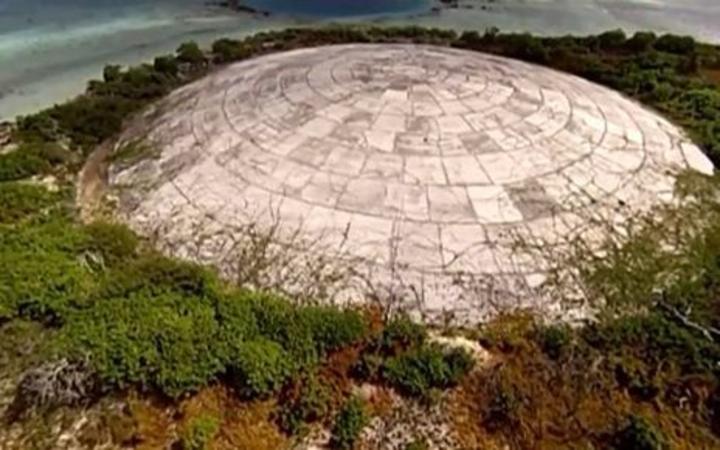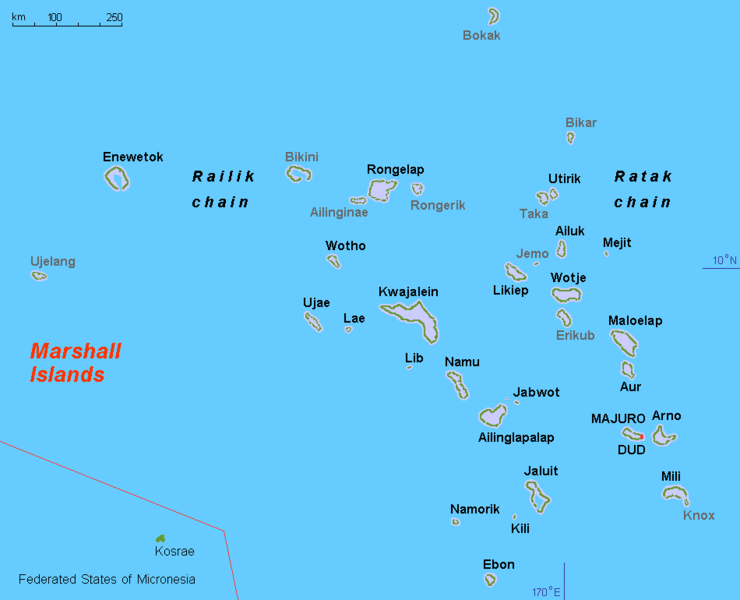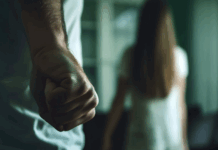
The US detonated its largest nuclear bombs around the Marshall Islands in the 1940s and 1950s – but the Marshallese are still campaigning for adequate compensation.
The Marshall Islands are two chains of 29 coral atolls in the middle of the Pacific Ocean between Papua New Guinea and Hawai’i.
Following the tests, whole islands ceased to exist, hundreds of native Marshallese had to be relocated off their home islands and many were affected by fallout from the testing.
In 1977, US authorities put the most contaminated debris and soil into a huge concrete dome called the Runit Dome, which sits on Enewetak Atoll and houses 88,000 square metres of contaminated soil and debris.
It has recently received media attention as it appears to be leaking, due to cracking and the threat from rising sea levels, while some Marshallese have fears it may eventually collapse.
However, American officials have said it is not their problem and responsibility falls on the Marshallese, as it is their land.
The US has cited a 1986 compact of free association, which released the US government from further liability, which will go up for renegotiation in 2023.
Meanwhile, the Marshallese continue to campaign for adequate compensation from the US.
First hand experience
Giff Johnson, editor of the country’s only newspaper, Marshall Islands Journal, and a RNZ correspondent, has experienced the unfolding legacy of US nuclear testing first hand. His wife Darlene Keju, an outspoken advocate for test victims and nuclear survivors, herself died of cancer in 1996.

While Johnson said that suggestions that the Runit Dome – nicknamed “The Tomb” by locals – was about to collapse were alarmist, there were still major concerns surrouding it.
“I wouldn’t say the dome is on the verge of collapse, there’s concern about its leaking, about cracks, and also about the overall contamination of that atoll,” he said.
“The issue is it’s got plutonium, which has a half-life of 24,000 years, and how long does concrete last?”
Describing the structure as a “symbol of the nuclear legacy here”, Johnson said that US government scientists had reported there was already so much contamination in the area that it would be difficult to find what leakage from the dome had added.
The United States has continued to refuse to accept responsibility for the Runit Dome’s condition, despite its history of nuclear testing in the country.
In 1954, the US carried out their first nuclear weapon test, Castle Bravo, at Bikini Atoll in 1954 – which resulted in the contamination of 15 islands and atolls. Only three years later, residents on the affected atolls of Rongelap and Utirik were encouraged to return to their homes, so researchers could study the effects of radiation.
Full compensation never paid
“The nuclear weapons test legacy is the overriding issue in the Marshall Islands with the United States and it remains a festering problem, because US compensation and medical care and so forth was only partial for what was needed,” Johnson said.
The first compact to free association between the Marshall Islands and the US contained a compensation agreement, including the establishment of a nuclear claims tribunal to adjudicate all claims. While it determined there was a large amount of compensation due to Marshallese on various atolls, this has never been paid out, apart from funding of $150 million in 1986.
Since then, the US has accepted no more liability on nuclear compensation, as the compact resulted in the Marshall Islands being an independent country, able to join the United Nations.
However, Johnson said the US Congress had taken a different position on this.
“For example, while the US executive branch would say, well the Marshall Islands is in charge of all the former nuclear test sites, the US Congress a few years back passed legislation requiring the US Department of Energy to monitor the Runit Dome, where so much radioactive waste is stored.”
There have also been big differences in the treatment of Marshallese nuclear victims and those in the United States
“The US used Bikini and Enewetak to test its biggest hydrogen bombs,” Johnson said.
“While it maintained a nuclear test site in Nevada, it only tested relatively small nuclear devices there, because it simply could not test hydrogen bombs in the continental United States – Americans wouldn’t have stood for it.”
Not long after the 1986 free association compact ended American responsibility for nuclear compensation in the Marshall Islands, the US Congress enacted a radiation compensation act for Americans – which Johnson said really emphasised the unfairness of the situation.
‘Long story short’
“Long story short, they appropriated $100 million and then they ran out, the US Congress appropriated more, again ran out, appropriated more and fast-forward to 2020 and they’re over $2 billion in compensation awarded to American nuclear victims.
“Then the question comes, that if they’re willing to just keep recapitalising the compensation fund for American nuclear victims, why aren’t they able to reinstitute the compensation fund for Marshallese, who were exposed to far more nuclear fallout than the downwinders in Utah and Nevada?”
Johnson also had concerns about the lack of a baseline epidemiological study by the US, following the tests. Studies on the affects of radiation centred around thyroid issues, but many islanders have reported cancer, miscarriages and stillbirths in the years following.
His wife Darlene Keju died of breast cancer, which also affected her mother and father – she grew up on one of the islands in the downwind zone of the tests.
The US had never looked at rates of cancer, or studied the differences between low fallout and high fallout areas, he said.
Johnson hoped the nuclear legacy between the countries could be worked out amicably, but he was not too optimistic.
“The original compensation agreement was negotiated in a period of the Cold War and the US did it in an adversarial way with the Marshall Islands, which had no standing because it wasn’t a country at the time, information was withheld, they didn’t know what they know today, and it needs to be worked out, a suitable decent fair agreement needs to be sorted out.”

‘Black mark’ on good relationship
Despite this tension, Johnson said the Marshallese did not harbour anti-American sentiment and the compensation issues were a “black mark on an otherwise good relationship” between the two countries.
He said around 30 to 40 percent of all Marshallese were living in the US.
“The Marshall Islands, since WWII, has had a very long standing high regard and strong relationship with the US that came out of the end of the Japanese period of militarism and the execution of many islanders and privation, into a period where the US fostered democratic institutions, created opportunities for education, providing scholarships, opening the door to people going to the US and the unpacked treaty really put this together, in terms of the relationship that’s of benefit to both sides.”
However, ongoing tensions between the US and China may help the Marshall Islands in their push for further compensation.
“In the current situation where we have the US continuing to be in an uproar over China … that has elevated the strategic importance of the Marshall Islands, the Federated States of Micronesia, Palau – the three north Pacific countries that are all in free association with the US. It does give the Marshall Islands a bit more leverage in negotiating and talking with Washington.
“Possibly the changing geopolitical situation out here might offer an opening to get some interest to try to amicably do something to resolve the whole thing,” Johnson said.
But the nuclear legacy is not the only issue affecting the island – climate change is looming large and reports by US scientists have said that the Marshall Islands could be uninhabitable by the 2030s, due to rising sea levels.
“Because the Marshall Islands has such little land, these are really small islands, it magnifies the importance of land to Marshallese people,” Johnson said.
“I think people care about their islands and want to find a way to make them liveable for the long term, but that may depend on the world community to a great extent now.”
This article is republished by the Pacific Media Centre under a partnership agreement with RNZ.










































